Landscape Changes and Optimization in an Ecological Red Line Area: A Case Study in the Upper Reaches of the Ganjiang River
Abstract
:1. Introduction
2. Data and Methods
2.1. Study Area
2.2. Data
2.3. Methods
2.3.1. Ecological Indices at the Patch Scales
- (1)
- Total class area (CA)where aij is the area of patch i in landscape j. CA measures the composition of landscape. It equals the sum of the areas of all patches of the corresponding patch type, namely total class area. CA approaches 0 when the ith patch becomes increasingly rare in the jth landscape. CA equals the total area when the entire image is comprised of a single patch. The size of the CA limits the number and abundance of species that live in such class.
- (2)
- Number of patches (NP), NP > 1where ni is the number of the ith patch. NP equals the total number of patches of a certain class. It reflects the spatial pattern of the landscape and is often used to indicate the heterogeneity of the entire landscapes. Its value has a good positive correlation with the fragmentation degree of the landscape. NP affects the spatial distribution and stability of species.
- (3)
- Percentage of patches (PLAND)where aij is the area of patch i in landscape j; A is the total landscape area. When its value approaches 0, the patch class becomes very rare in the landscape. When the value is equal to 100, it indicates that the whole landscape consists of only one class. PLAND measures landscape components and the relative area of a patch class in the landscape, influencing ecosystem indicators such as biodiversity, dominant species, and abundance.
- (4)
- Patch density (PD)where ni is the total number of patch i in the landscape; A is the total area of the landscape. PD reflects the number of patches per unit area and can compare the types of patch composition among landscapes of varying size.
- (5)
- Largest patch index (LPI)where aij is the area of patch i in landscape j. LPI is helpful to determine the spatial pattern or dominant type of the landscape.
- (6)
- Perimeter–area fractal dimension index (PAFRAC)where aij is the area of patch i in landscape j; pij is the perimeter of patch i; ni is the total number of patches in the landscape. PAFRAC is used to measure the shapes of patches or landscapes. When PAFRAC tends to 1, the shape of patches tends to square. As it approaches 2, the patch shape tends to be highly convoluted, with plane-filling perimeters.
- (7)
- Aggregation index (AI)where gii is the aggregation index of like adjacent patch numbers of type i based on single-count algorithm; max(gij) is the maximum of gii; AI reflects the nonrandomness or aggregation degree of various patch classes in the landscape, and can reflect the spatial configuration characteristics of landscape composition. If the landscape is composed of many discrete patches, AI is small, but when the landscape is dominated by a few large patches or the same type of patches are highly connected, AI is large.
- (8)
- Patch cohesion index (COHESION)where pij is the perimeter of patch ij measured by pixel surface; aij is the area of the patch ij measured by pixels; Z is the total number of pixels in the landscape. COHESION measures the physical connectedness of the corresponding patch, and it is sensitive to the aggregation of the focal class below the percolation threshold.
2.3.2. Ecological Indices at the Landscape Scales
- (9)
- Shannon diversity index (SHDI)where pi is the proportion of the landscape occupied by patch i. SHDI = 0 indicates that the whole landscape consists of only one patch (no diversity). The increase in SHDI indicates the increase in patch classes or the trend distribution of each patch class in the landscape. SHDI is a measurement based on information theory, which can reflect landscape heterogeneity and is especially sensitive to the unbalanced distribution of various patch classes in the landscape. In a landscape system, the richer the landscape is, the higher the degree of fragmentation is, the greater the uncertainty information content is, and the higher the SHDI value is.
- (10)
- Shannon’s evenness index (SHEI)where pi is the proportion of the landscape occupied by patch i; m is the number of patch types (classes) present in the landscape. SHEI = 0 indicates that the landscape consists of only one patch without diversity. SHEI = 1 indicates that all patch classes were evenly distributed and had the greatest diversity. SHEI is a powerful means of comparing diversity changes between the various landscapes or within the same landscape over time. When SHEI approaches 1, the dominance degree is low, indicating that there is no obvious dominant type in the landscape and all patch classes are evenly distributed in the landscape.
3. Results
3.1. Landscape Changes
3.2. Ecological Succession and Human Disturbance
3.3. Characteristics of the Landscape Patterns
3.4. Changes of the Ecological Indices at the Patch Scale
3.4.1. Changes in the PD
3.4.2. Changes in the PAFRAC
3.4.3. Changes in the AI
3.5. Changes of the Ecological Indices at the Landscape Scale
4. Discussion
5. Conclusions and Optimization Suggestion
- (1)
- The ecosystems in the ERL of the study area are effective in providing the ecosystem services of carbon sink function, biodiversity conservation, and water conservation function, especially due to the large percentage of forest cover. Forests are the largest and most important class of all the six ecological landscapes, accounting for more than 81% of the total study area.
- (2)
- The natural ecosystems in the study area keep relatively stable during 1986–2018. According to the indices at the landscape scales, the degree of landscape fragmentation in the study area decreased from 1986 to 2005. The diversity and richness of the landscape gradually increased from 2010 to 2018. The dominant characteristics of the forests were enhanced. The proportion of landscape types that have succeeded is very small. The ecosystems and aggregation can recover quickly after being disturbed by human activities.
- (3)
- According to the data from 2018, the study area was a good biological habitat area in the UR-GJ. The patch area was large. The dominant ecological types accounted for a high proportion, and most of them were top successional biological types. The dominant position of the forest landscapes was stable and increased, and there existed an obvious aggregation effect. The PAFRACs of all the six landscape types decreased, and the AIs of forests and grasslands increased. These findings demonstrated that during the period from 2010 to 2018, forest patches were gradually becoming connected, grasslands tended to be fragmented, and the patch shapes developed toward regularization. It was an ideal biodiversity conservation area and water conservation area.
- (4)
- There exist obvious human activity disturbances to the ecosystem in the ERL during 1986–2018. The proportion of croplands was approximately 11% of the total area. The analysis of ecological succession found that human settlements expanded to ecological areas from 2010 to 2018. The ecological index of the patch scales also showed a fragmentation trend from 1995 to 2010, and the phenomenon of the croplands and settlement landscapes invading the natural ecosystem. The establishment of effectively designed and managed ERLs will have a positive effect in maintaining the natural ecosystems that have been providing substantial ecosystem services to the study area.
- (1)
- The conversion of large-scale croplands to forests could be the key to maintaining the stability of the ecosystem in the future in the ERL. Croplands account for approximately 11% of the total area. It is important to return croplands to forests so as to reduce the impact of human activities on the ecosystem. Croplands are easily driven by policy and the economy, and the proportion of croplands in the study area is more scattered, less connected, and low in aggregation. The patch of croplands is relatively fragmented and has difficulty forming a scale advantage. The natural conditions have an obvious restrictive effect on agricultural development. Expanding human settlements indicate that a combination of increasing yields from highly productive agricultural land and converting marginal grasslands and agricultural land to forests would yield greater benefits from the delivery of essential ecosystem services such as watershed protection and biodiversity conservation. Under the expansion condition of human settlements, the transformation of large-scale croplands to forests could be the key to maintaining the stability of the ecosystem in the study area.
- (2)
- The ERLs need to be protected against ecological disruption, with measures such as strictly prohibiting human production activities in the mountains to facilitate afforestation. This will allow the disturbed landscapes to recover under the natural drives of good climate, soils, and geology and gradually reach successional climaxes. These measures will increase the proportion of natural forests and continuously optimize the ecosystem functions of the study area.
- (3)
- According to the characteristics of ecological patches in the study area, it is recommended to pay special attention to the establishment and maintenance of the largest patch ecosystems during ecological management. The LPI in the study area was only approximately 8, and it declined in 2005. Under fragmentation conditions, the establishment of the largest patch should be paid attention to so as to optimize management, and this can help realize contiguous development and the aggregation effect of key landscape types such as forests and grasslands.
Author Contributions
Funding
Institutional Review Board Statement
Informed Consent Statement
Conflicts of Interest
References
- Forman, R. Some general principles of landscape and regional ecology. Landsc. Ecol. 1995, 10, 133–142. [Google Scholar] [CrossRef]
- Xiao, D.; Chen, W. On the basic concepts and contents of ecological security. J. Appl. Ecol. 2002, 13, 354–358. (In Chinese) [Google Scholar]
- Scherr, S.; Buck, L.; Willemen, L.; Milder, J. Ecoagriculture: Integrated landscape management for people, food, and nature. In Encyclopedia of Agriculture and Food Systems; Academic Press: Cambridge, MA, USA, 2014; Volume 3. [Google Scholar]
- Hubert-Moy, L.; Thibault, J.; Fabre, E.; Rozo, C.; Arvor, D.; Corpetti, T.; Rapinel, S. Mapping grassland frequency using decadal MODIS 250 m time-series: Towards a national inventory of semi-natural grasslands. Remote Sens. 2019, 11, 3041. [Google Scholar] [CrossRef]
- Blann, K. Habitat in agricultural landscapes: How much is enough. In A State-of-the-Science Literature Review; Defenders of Wildlife: West Linn, OR, USA, 2006. [Google Scholar]
- Goldstein, M.I.; DellaSala, D.A. Encyclopedia of the World’s Biomes; Elsevier: Amsterdam, The Netherlands, 2020. [Google Scholar]
- Hersperger, A.M.; Grădinaru, S.R.; Pierri Daunt, A.B.; Imhof, C.S.; Fan, P. Landscape ecological concepts in planning: Review of recent developments. Landsc. Ecol. 2021, 36, 2329–2345. [Google Scholar] [CrossRef]
- Wu, J. Landscape sustainability science: Ecosystem services and human well-being in changing landscapes. Landsc. Ecol. 2013, 28, 999–1023. [Google Scholar] [CrossRef]
- Reed, J.; Van Vianen, J.; Deakin, E.L.; Barlow, J.; Sunderland, T. Integrated landscape approaches to managing social and environmental issues in the tropics: Learning from the past to guide the future. Glob. Chang. Biol. 2016, 22, 2540–2554. [Google Scholar] [CrossRef]
- Nassauer, J.I.; Opdam, P. Design in science: Extending the landscape ecology paradigm. Landsc. Ecol. 2008, 23, 633–644. [Google Scholar] [CrossRef]
- Hassan, D.K.; Hewidy, M.; El Fayoumi, M.A. Productive urban landscape: Exploring urban agriculture multi-functionality practices to approach genuine quality of life in gated communities in Greater Cairo Region. Ain Shams Eng. J. 2022, 13, 101607. [Google Scholar] [CrossRef]
- Forman, R.T. The Urban Region: Natural Systems in Our Place, Our Nourishment, Our Home Range, Our Future; Springer: Berlin/Heidelberg, Germany, 2008; Volume 23, pp. 251–253. [Google Scholar]
- Gao, K. Multi-Scale Landscape Spatial Relationship and Changes of Landscape Pattern and Ecological Effect; Huazhong Agricultural University: Hanzhou, China, 2010. (In Chinese) [Google Scholar]
- Guo, J.; Zhou, Z. Landscape Ecology; China Forestry Publishing House: Beijing, China, 2007. (In Chinese) [Google Scholar]
- Wu, T.; Zha, P.; Yu, M.; Jiang, G.; Zhang, J.; You, Q.; Xie, X. Landscape pattern evolution and its response to human disturbance in a newly metropolitan area: A case study in Jin-Yi metropolitan area. Land 2021, 10, 767. [Google Scholar] [CrossRef]
- Stritih, A.; Senf, C.; Seidl, R.; Grêt-Regamey, A.; Bebi, P. The impact of land-use legacies and recent management on natural disturbance susceptibility in mountain forests. For. Ecol. Manag. 2021, 484, 118950. [Google Scholar] [CrossRef]
- Nie, W.; Yang, F.; Xu, B.; Bao, Z.; Shi, Y.; Liu, B.; Wu, R.; Lin, W. Spatiotemporal Evolution of Landscape Patterns and Their Driving Forces Under Optimal Granularity and the Extent at the County and the Environmental Functional Regional Scales. Front. Ecol. Evol. 2022, 10, 954232. [Google Scholar] [CrossRef]
- Su, L.; Zhu, J.; Ren, S.; Fu, L. Review of research methods for driving force analysis of landscape pattern changes. Resour. Environ. Dev. 2013, 1, 26–29. (In Chinese) [Google Scholar]
- Chen, J. Evolution and Simulation of Forest Landscape Pattern in Ningxiang City Based on RS and GIS; Central South University of Forestry and Technology: Changsha, China, 2020. (In Chinese) [Google Scholar]
- Chen, X.; Gao, X.; Xu, J.; Jin, Y.; Zhang, Y.; Wang, C. Analysis of the pattern change process of Changbai Mountain wind-damaged landscape in the past thirty years. J. Ecol. 2022, 42, 13. (In Chinese) [Google Scholar]
- Yu, X.; Ji, Y.; Wang, L.; Xu, M. Research on Landscape Pattern Change and Driving Mechanism in Tiaozi Mud Reclamation Area in Jiangsu. J. Nanjing Norm. Univ. Nat. Sci. Ed. 2022, 45, 55–63. [Google Scholar]
- Chen, X. On the definition of the concept of ecological red line. Doctoral Dissertation, Chongqing University, Chong Qing, China, 2016. (In Chinese). [Google Scholar]
- Rao, S.; Zhang, Q.; Mu, X. Delineation of ecological red lines to innovate ecosystem management. Environ. Econ. 2012, 2012, 4. (In Chinese) [Google Scholar]
- Xinhua-News-Agency. Decision of the Central Committee of the Communist Party of China on Some Major Issues Concerning Comprehensively Deepening the Reform. China Coop. Econ. 2013, 2013, 14. (In Chinese) [Google Scholar]
- Ministry-of-Environmental-Protection. Guidelines for Delineation of Ecological Protection Red Lines. Environ. Prot. Work Mater. Sel. 2017, 2017, 19–23, 14. (In Chinese) [Google Scholar]
- Xinhua-News-Agency. The General Office of the Central Committee of the Communist Party of China and the General Office of the State Council issued “Several Opinions on Delimiting and Strictly Observing the Red Lines of Ecological Protection”. China’s For. Ind. 2018, 2018, 29–33. [Google Scholar]
- Cui, S. Ministry of Ecology and Environment: The Delimitation of the National Ecological Protection Red Line Is Basically Completed. Available online: https://paper.sciencenet.cn/htmlnews/2021/7/460862.shtm (accessed on 10 August 2022).
- Min, Q.; Ma, N. The Difference and Relationship between Ecological Protection Redlines and Nature Reserves System. Environ. Prot. 2017, 45, 26–30. (In Chinese) [Google Scholar]
- Zhang, Y.; Hou, L. Study on red line delineation methods for ecological protection in southwestern cities—Taking Mianyang City as an example. Jiangsu Agric. Sci. 2020, 48, 268–275. (In Chinese) [Google Scholar]
- He, X.; Guo, J. Research on the management and control of ecological protection red lines from the perspective of county space—Taking Zixi County, Jiangxi Province as an example. Old Dist. Constr. 2020, 2020, 32–42. (In Chinese) [Google Scholar]
- Xing, M.; Liu, Y.; Yang, X.; Zha, Y.; Zhang, J. Study on Ecological Protection and Development of Small Watersheds Based on Ecological Protection Redlines. Yellow River 2021, 43, 120–123. [Google Scholar]
- Hu, M.; Ye, C.; Lu, L. Study on the Delimitation of Ecological Space and Ecological Protection Red Line in Nanchang City. Ecol. Environ. Sci. 2021, 30, 631–643. (In Chinese) [Google Scholar]
- Wang, Z.G.; Nan, W.U. Study on the Method of Ecological Protection Red Line Delineation in Anhui Province Based on GIS. J. Jiangsu Normal Univ: Nat. Sci. Ed. 2018, 41, 281–292. (In Chinese) [Google Scholar]
- Yan, S.G.; Lin, N.F.; Shen, W.S. Delineation and Protection of Ecological Red Lines in Jiangsu Province. J. Ecol. Rural Environ. 2014, 30, 294–299. (In Chinese) [Google Scholar]
- Yang, S.S.; Zou, C.X.; Shen, W.S.; Shen, R.P.; Xu, D.L. Construction of ecological security patterns based on ecological red line: A case study of Jiangxi Province. Chin. J. Ecol. 2016, 35, 250–258. (In Chinese) [Google Scholar]
- Xie, Y.T.; Zhou, Z.F.; Yan, L.H.; Niu, Y.C.; Wang, L. Study on spatial variation and control measures of ecological red line in rocky desertification sensitive area of guizhou province. Res. Environ. Yangtze Basin 2017, 26, 624–630. (In Chinese) [Google Scholar]
- Xu, C.; Meng, N.; Zhang, Y.; Xie, S.; Han, B.; Su, Z.; Lin, Z.; Lu, F.; Ouyang, Z. Urban ecological conservation redlines delineation and management:A case study of Macao Special Administrative Region. Acta Ecol. Sin. 2021, 41, 15. (In Chinese) [Google Scholar]
- People’s Government of Jiangxi ProvinceGovernment. Plan for the Delineation of Ecological Protection Red Lines in Jiangxi Province. Available online: http://xxgk.jiangxi.gov.cn/gddt/zwdt/201807/t20180709_1457059.htm (accessed on 16 December 2019).
- Li, S.; Qiu, F.; Wang, S. Practice and Thinking on Prevention and Control of Mountain Flood Disaster in Jiangxi. China Water Conserv. 2012, 2012, 51–54. (In Chinese) [Google Scholar]
- Forman, R.T.; Godron, M. Patches and structural components for a landscape ecology. BioScience 1981, 31, 733–740. [Google Scholar]
- Forman, R. Land Mosaics: The ecology of landscapes and regions (1995). Ecol. Des. Plan. Read. 2014, 36, 217–234. [Google Scholar]
- Marten, G.G. Human Ecology: Basic Concepts for Sustainable Development; Routledge: London, UK, 2010. [Google Scholar]
- Bazzaz, F. The physiological ecology of plant succession. Annu. Rev. Ecol. Syst. 1979, 10, 351–371. [Google Scholar] [CrossRef]
- McMichael, A.; Hefny, M.; Foale, S. Linking Ecosystem Services and Human Well-being. Ecosyst. Hum. Well-Being 2005, 43, 1–13. [Google Scholar]
- Hulme, M. One earth, many futures, no destination. One Earth 2020, 2, 309–311. [Google Scholar] [CrossRef]
- Steffen, W.; Richardson, K.; Rockström, J.; Cornell, S.E.; Fetzer, I.; Bennett, E.M.; Biggs, R.; Carpenter, S.R.; De Vries, W.; De Wit, C.A. Planetary boundaries: Guiding human development on a changing planet. Science 2015, 347, 1259855. [Google Scholar] [CrossRef] [PubMed]
- Xu, X.; Tan, Y.; Yang, G.; Barnett, J. China’s ambitious ecological red lines. Land Use Policy 2018, 79, 447–451. [Google Scholar] [CrossRef]
- Gao, J.; Wang, Y.; Zou, C.; Xu, D.; Lin, N.; Wang, L.; Zhang, K. China’s ecological conservation redline: A solution for future nature conservation. Ambio 2020, 49, 1519–1529. [Google Scholar] [CrossRef]
- Bai, Y.; Wong, C.P.; Jiang, B.; Hughes, A.C.; Wang, M.; Wang, Q. Developing China’s Ecological Redline Policy using ecosystem services assessments for land use planning. Nat. Commun. 2018, 9, 3034. [Google Scholar] [CrossRef]
- Hannah, L.; Lohse, D.; Hutchinson, C.; Carr, J.L.; Lankerani, A. A preliminary inventory of human disturbance of world ecosystems. Ambio 1994, 23, 246–250. [Google Scholar]
- Doherty, T.S.; Hays, G.C.; Driscoll, D.A. Human disturbance causes widespread disruption of animal movement. Nat. Ecol. Evol. 2021, 5, 513–519. [Google Scholar] [CrossRef]
- Steibl, S.; Laforsch, C. Disentangling the environmental impact of different human disturbances: A case study on islands. Sci. Rep. 2019, 9, 13712. [Google Scholar] [CrossRef] [PubMed]
- Gaynor, K.M.; Hojnowski, C.E.; Carter, N.H.; Brashares, J.S. The influence of human disturbance on wildlife nocturnality. Science 2018, 360, 1232–1235. [Google Scholar] [CrossRef] [PubMed] [Green Version]
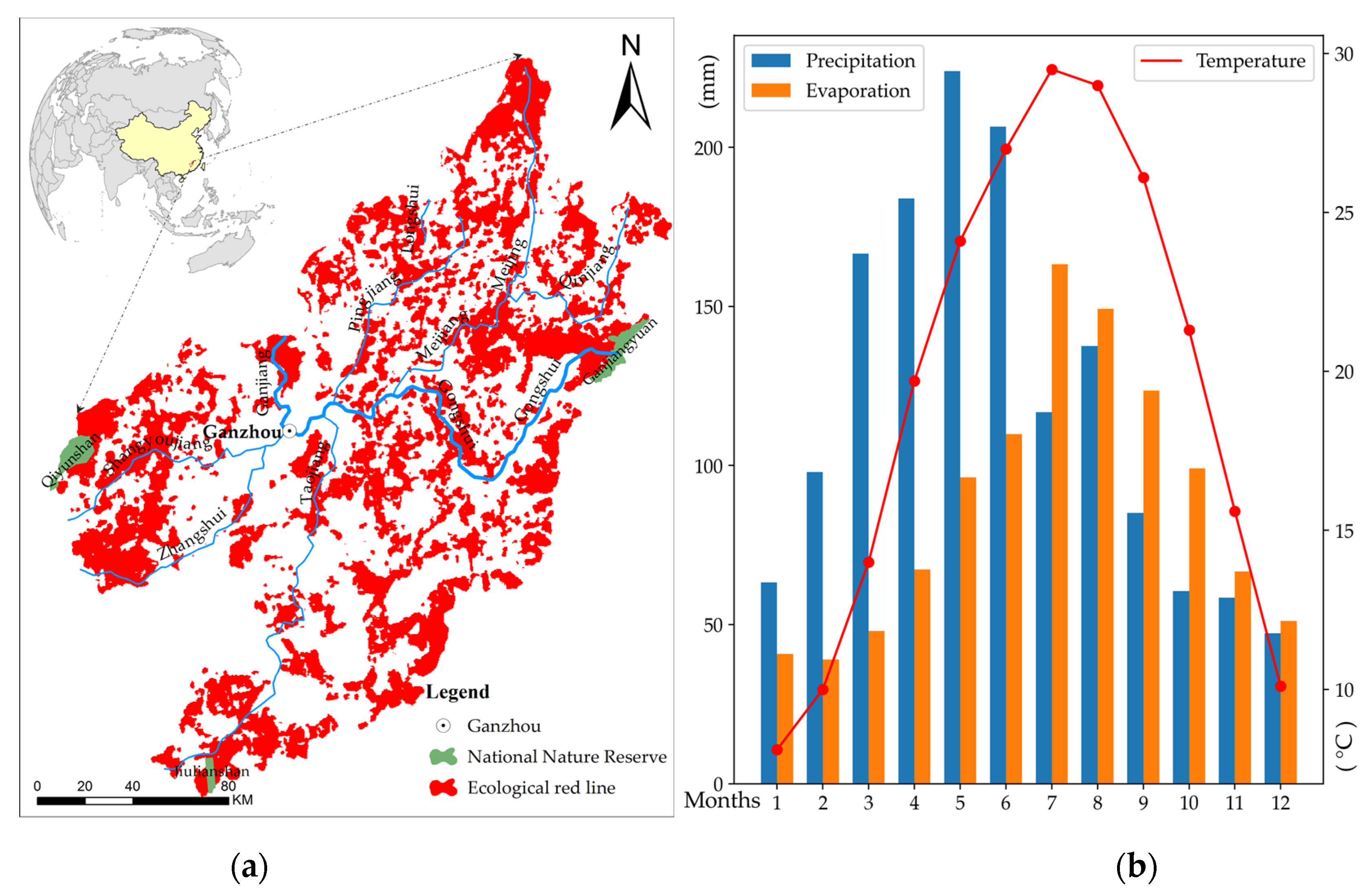
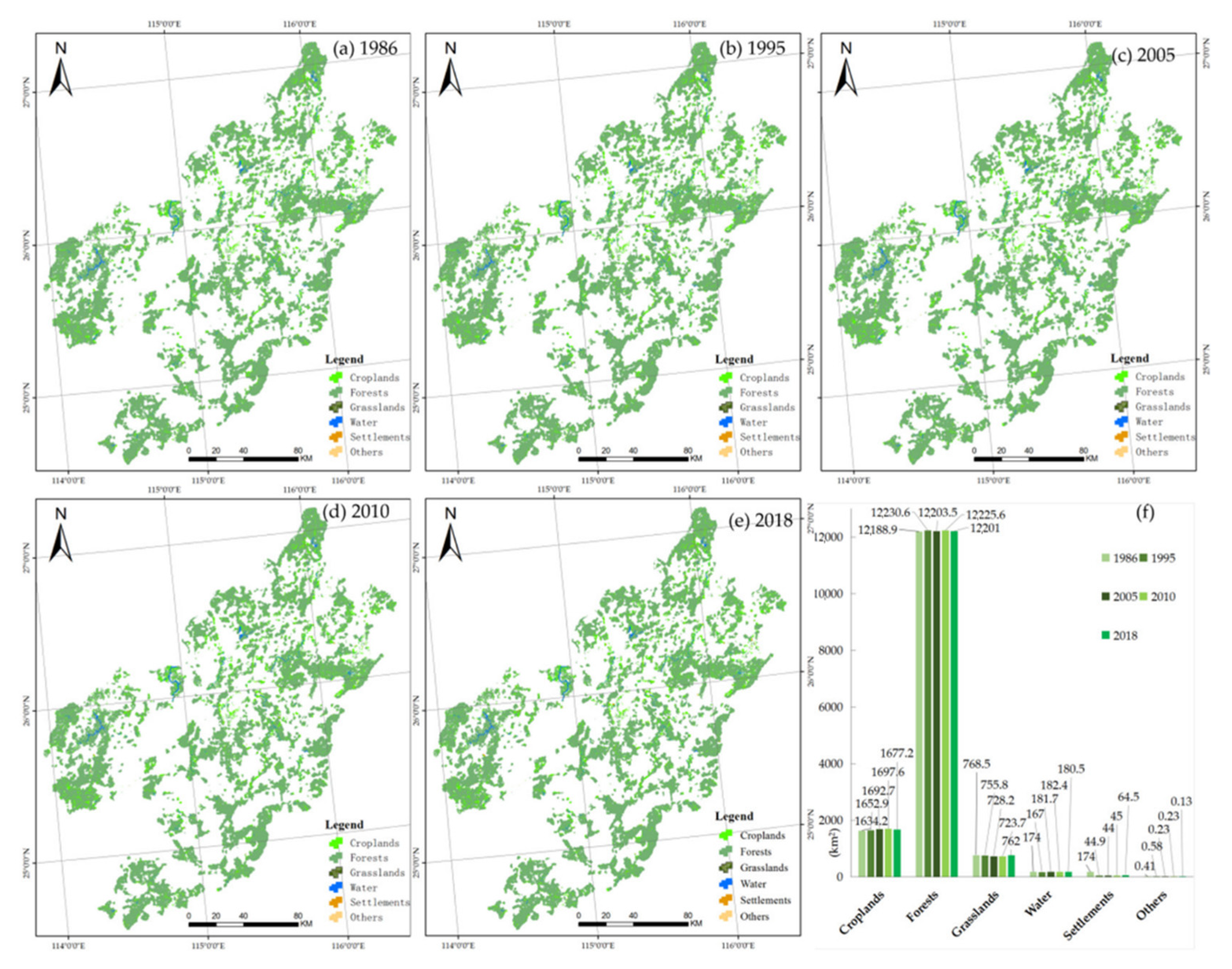
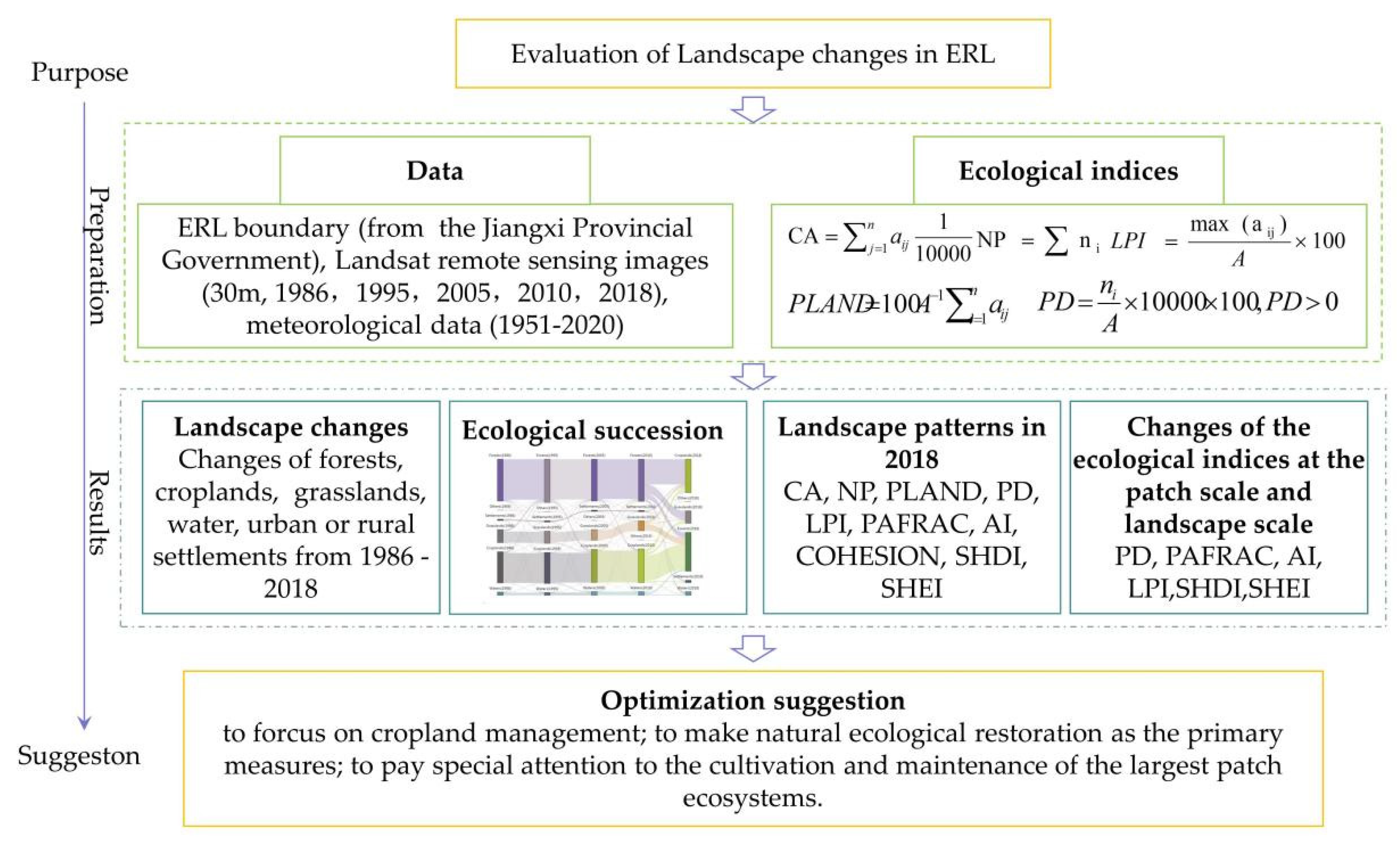
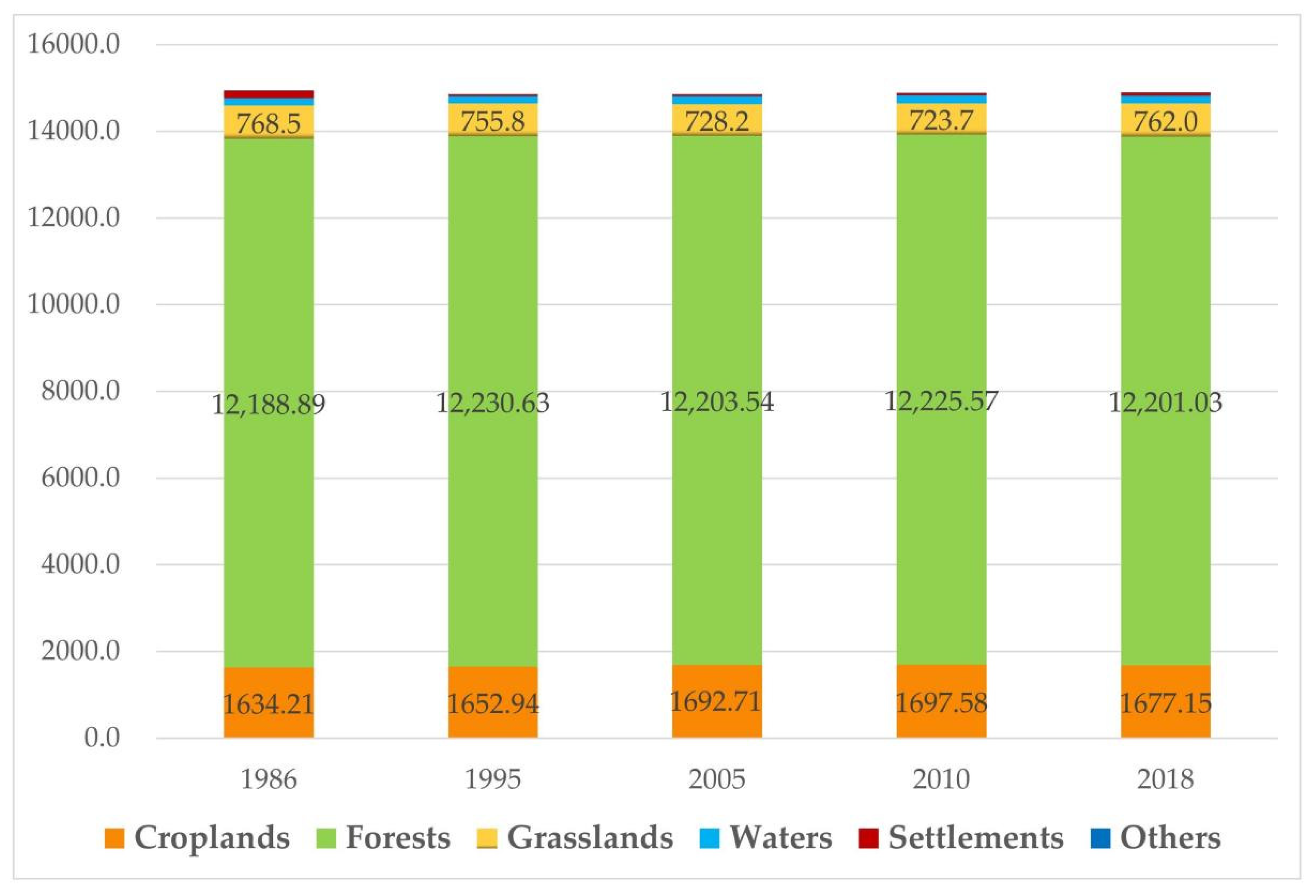
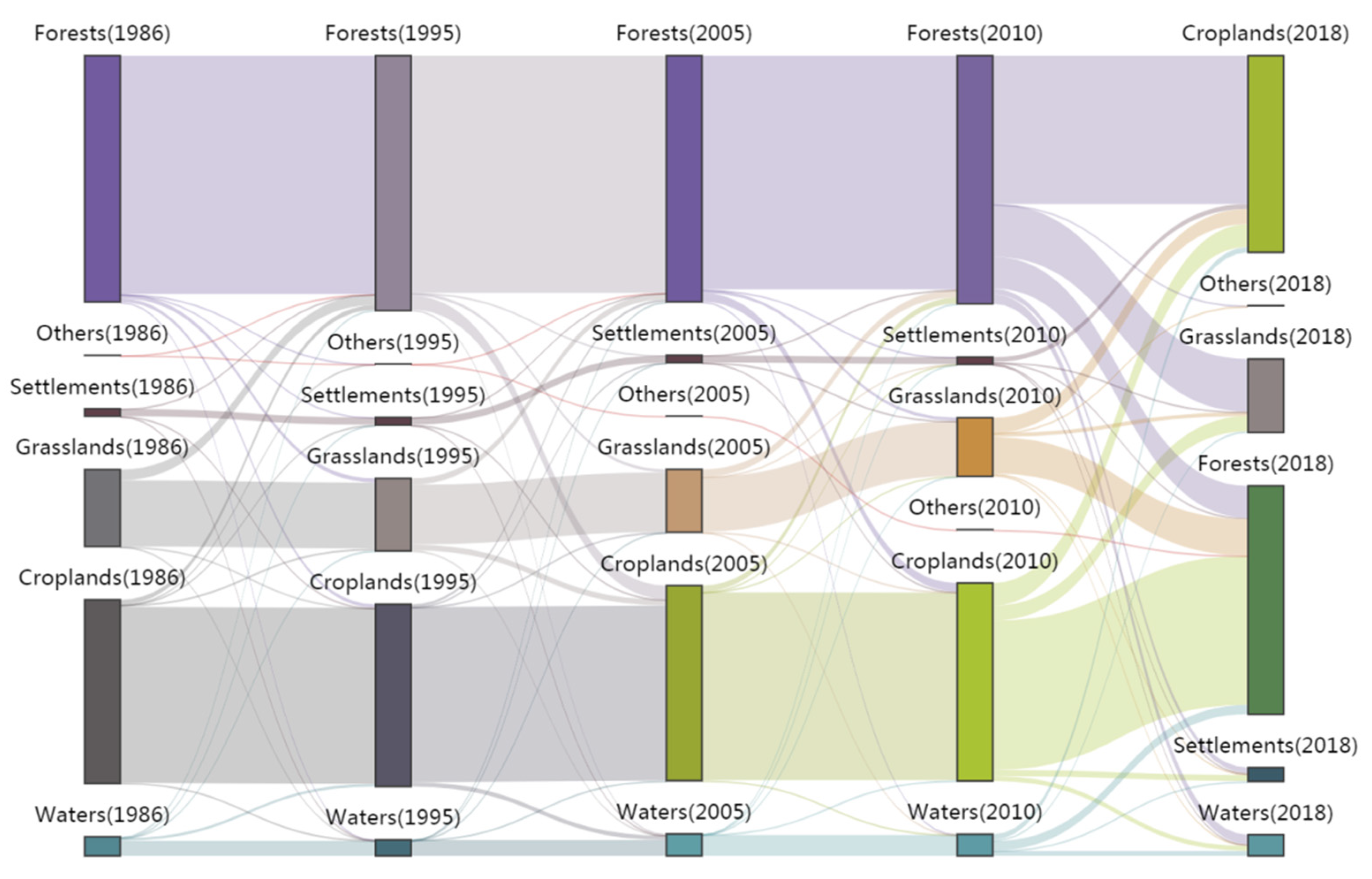

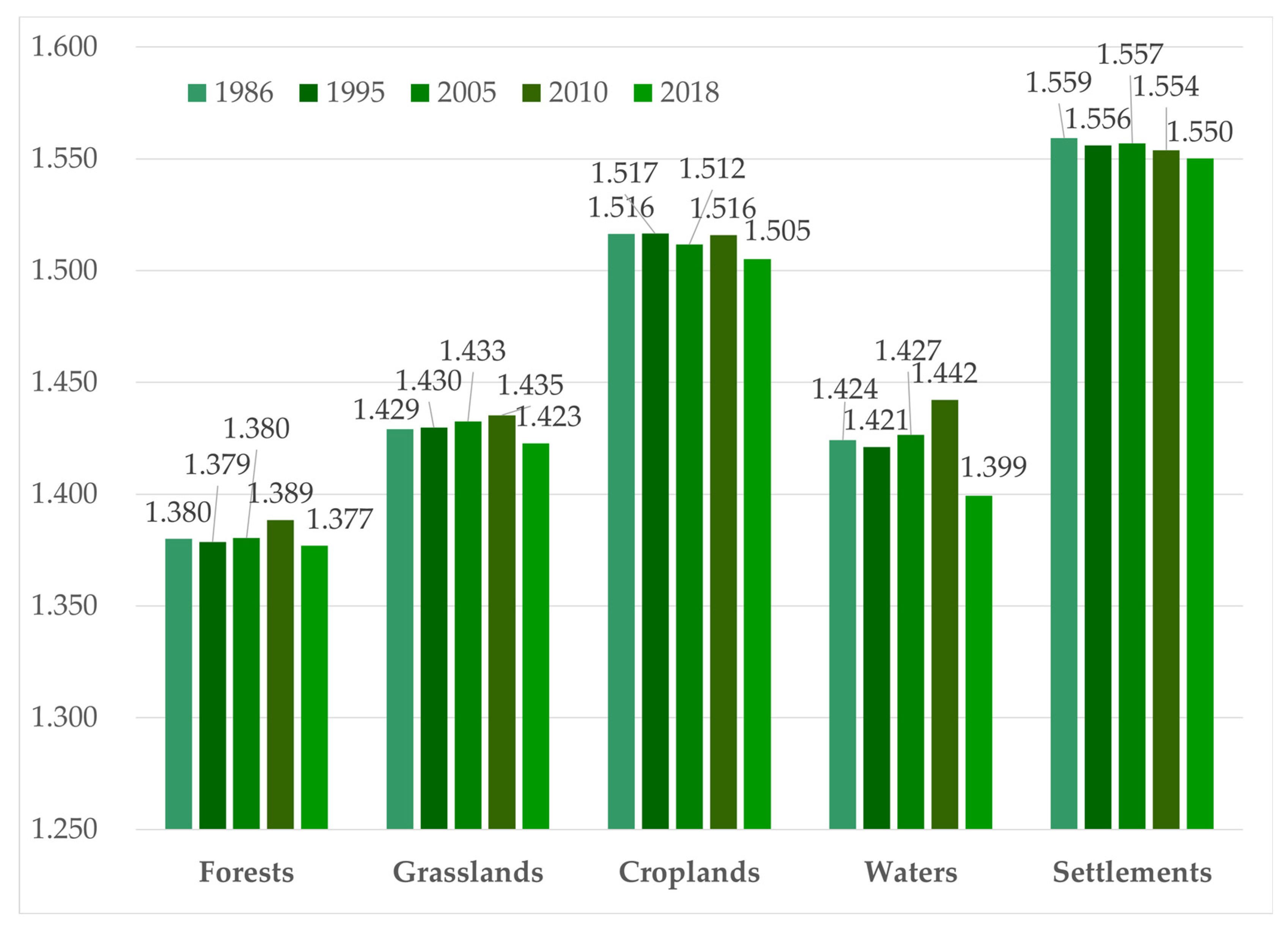

| Authors | Approaches | Places | References |
|---|---|---|---|
| Wang ad Nan | Indicator: water conservation, soil and water conservation, biodiversity protection, water resource protection, and flood regulation as indicators. Method: GIS | Anhui Province | [33] |
| Yan et al. | Methods: evaluation of the importance of ecosystem services | Jiangsu Province | [34] |
| Yang et al. | Method: the least-resistance model for maintaining the ecological security pattern | Jiangxi Province | [35] |
| Xie et al. | Method: GIS and ecological sensitivity evaluation | Guizhou Province | [36] |
| Xu et al. | Method: a comprehensive multifactor analysis | Macao | [37] |
| Year | 1986 | 1995 | 2005 | 2010 | 2018 | |||||
|---|---|---|---|---|---|---|---|---|---|---|
| Landscape Types | Area (km2) | Proportion (%) | Area (km2) | Proportion (%) | Area (km2) | Proportion (%) | Area (km2) | Proportion (%) | Area (km2) | Proportion (%) |
| Croplands | 1634.2 | 10.9 | 1652.9 | 11.1 | 1692.7 | 11.4 | 1697.6 | 11.4 | 1677.2 | 11.3 |
| Forests | 12,188.9 | 81.6 | 12,230.6 | 82.4 | 12,203.5 | 82.2 | 12,225.6 | 82.2 | 12,201.0 | 82.0 |
| Grasslands | 768.5 | 5.1 | 755.8 | 5.1 | 728.2 | 4.9 | 723.7 | 4.9 | 762.0 | 5.1 |
| Water | 174.0 | 1.2 | 167.0 | 1.1 | 181.7 | 1.2 | 182.4 | 1.2 | 180.5 | 1.2 |
| Settlements | 174.0 | 1.2 | 44.9 | 0.3 | 44.0 | 0.3 | 45.0 | 0.3 | 64.5 | 0.4 |
| Others | 0.41 | 0.003 | 0.580 | 0.000 | 0.230 | 0.000 | 0.230 | 0.000 | 0.130 | 0.001 |
| Landscapes | CA (hm2) | PLAND (%) | NP | PD | LPI | PAFRAC | COHESION | AI |
|---|---|---|---|---|---|---|---|---|
| Croplands | 167,715 | 11.3 | 9420 | 0.6 | 0.1 | 1.51 | 87.8 | 63.5 |
| Forests | 1,220,103 | 82.0 | 1853 | 0.1 | 7.9 | 1.38 | 99.5 | 92.5 |
| Grasslands | 76,200 | 5.1 | 2325 | 0.2 | 0.2 | 1.42 | 90.3 | 73.4 |
| Water | 18,052 | 1.2 | 423 | 0.0 | 0.2 | 1.55 | 94.4 | 70.4 |
| Settlement | 6445 | 0.4 | 1260 | 0.1 | 0.0 | 1.40 | 62.9 | 47.5 |
| Others | 13 | 0.0 | 4 | 0.0 | 0.0 | N/A | 46.1 | 50.0 |
| Years | NP | PD | LPI | PAFRAC | SHDI | SHEI | AI |
|---|---|---|---|---|---|---|---|
| 1986 | 15,427 | 1.042 | 8.060 | 1.452 | 0.628 | 0.350 | 87.535 |
| 1995 | 15,338 | 1.031 | 8.045 | 1.452 | 0.623 | 0.348 | 87.632 |
| 2005 | 15,308 | 1.029 | 7.958 | 1.452 | 0.627 | 0.350 | 87.569 |
| 2010 | 15,765 | 1.060 | 7.949 | 1.459 | 0.626 | 0.349 | 87.273 |
| 2018 | 15,285 | 1.027 | 7.853 | 1.442 | 0.638 | 0.356 | 87.789 |
Publisher’s Note: MDPI stays neutral with regard to jurisdictional claims in published maps and institutional affiliations. |
© 2022 by the authors. Licensee MDPI, Basel, Switzerland. This article is an open access article distributed under the terms and conditions of the Creative Commons Attribution (CC BY) license (https://creativecommons.org/licenses/by/4.0/).
Share and Cite
Liu, G.; Xiang, A.; Huang, Y.; Zha, W.; Chen, Y.; Mao, B. Landscape Changes and Optimization in an Ecological Red Line Area: A Case Study in the Upper Reaches of the Ganjiang River. Int. J. Environ. Res. Public Health 2022, 19, 11530. https://doi.org/10.3390/ijerph191811530
Liu G, Xiang A, Huang Y, Zha W, Chen Y, Mao B. Landscape Changes and Optimization in an Ecological Red Line Area: A Case Study in the Upper Reaches of the Ganjiang River. International Journal of Environmental Research and Public Health. 2022; 19(18):11530. https://doi.org/10.3390/ijerph191811530
Chicago/Turabian StyleLiu, Guangxu, Aicun Xiang, Yimin Huang, Wen Zha, Yaofang Chen, and Benjin Mao. 2022. "Landscape Changes and Optimization in an Ecological Red Line Area: A Case Study in the Upper Reaches of the Ganjiang River" International Journal of Environmental Research and Public Health 19, no. 18: 11530. https://doi.org/10.3390/ijerph191811530
APA StyleLiu, G., Xiang, A., Huang, Y., Zha, W., Chen, Y., & Mao, B. (2022). Landscape Changes and Optimization in an Ecological Red Line Area: A Case Study in the Upper Reaches of the Ganjiang River. International Journal of Environmental Research and Public Health, 19(18), 11530. https://doi.org/10.3390/ijerph191811530





